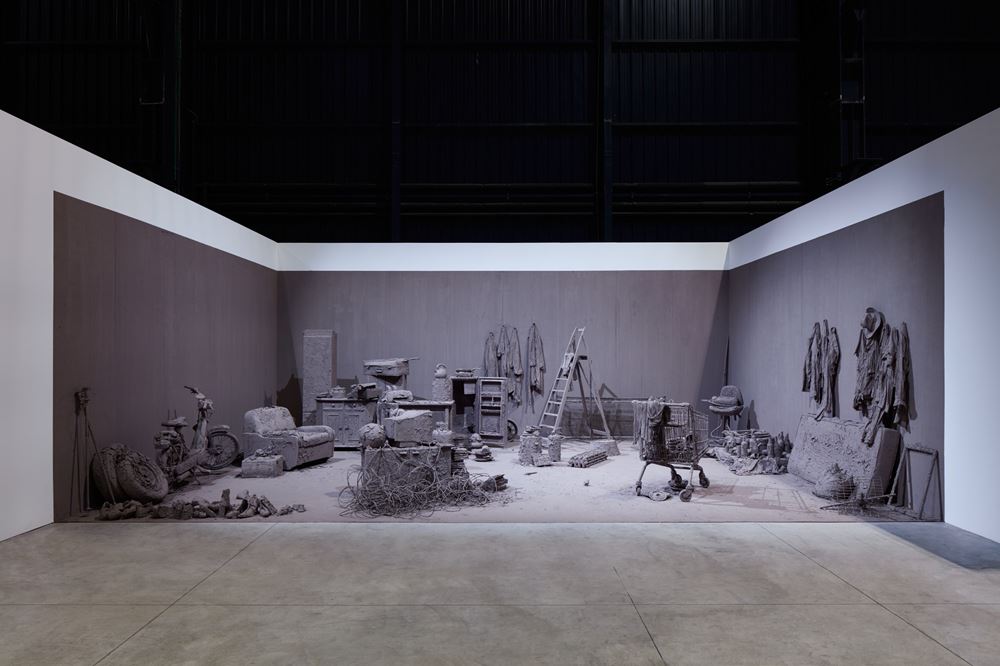15/10/2020
Chen Zhen I Short-circuits
From 15 October 2020 to 21 February 2021, Pirelli HangarBicocca presents Short-circuits a retrospective exhibition curated by Vicente Todolí, devoted to Chen Zhen, one of the leading figures of contemporary art. Celebrated by the world’s most important museums, the artist managed to bridge the gap between the art of the East and that of the West, with works of great visual impact that anticipated the socio-political complexities of today, addressing themes such as globalisation and consumerism, and their relationship with tradition.
The display includes more than twenty large-scale installations created by the artist in the last ten years of his life, until 2000, with numerous loans from major Italian and international institutions and collections.
The exhibition is a journey through some of the artist’s most important works, which convey the idea of the interdependence between the material and spiritual world, through reflections on the curative and purifying action of art and on the metaphorical processes of illness and healing.
The artist
Chen Zhen (Shanghai 1955- Paris 2000) developed his art from the late 1970s. Born and raised in Shanghai, he lived through the Cultural Revolution in China during his adolescence and moved to Paris in 1986, where he died in 2000. While initially oriented towards painting, he gradually moved towards the creation of installations (creating his first one in 1989, after his move to Paris). In them, he brought together everyday objects such as beds, chairs, and tables, assembling them in compositions that took the items away from their original functions and into a metaphorical dimension. Chen Zhen’s art paradigmatically reflects his wish to find a visual synthesis that would integrate the aesthetic dimension of his homeland with that of the places he came into contact with, in a constant, fluid exchange between Eastern and Western thought. The concept of transexperiences is thus pivotal: the term, coined by the artist himself, “summarises vividly and profoundly the complex life experiences of leaving one’s native place and going from one place to another” [Transexperiences: A Conversation between Chen Zhen and Xian Zhu, quoted in Chen Zhen Un artista fra Oriente e Occidente, ed. J.-H. Martin, Gli Ori, Prato-Siena, 2003].
Chen Zhen’s personal experiences further affected his artistic path, for at the age of 25 he was diagnosed with a form of haemolytic anaemia. This event influenced his perception of both time and space, and brought him to consider the theme of illness. This led the artist, who had been born into a family of doctors, to a new level of sensitivity with regard to the human body and the elements that compose it, as Chen Zhen himself put it: “as an artist, my dream is to become a doctor. Making art is all about looking at oneself, examining oneself and somehow seeing the world” [Becoming a Doctor, a Life Project, in Invocation of Washing Fire, Gli Ori Editore, Prato-Siena, 2003, pp. 335-338]. This led to a reflection on the curative and purifying action of art and on the metaphorical processes of illness and healing. His work began to point to the complex, sometimes paradoxical, interdependence between the material and the spiritual, the collective and the individual, and between the inner self and outward appearance.
The exhibition
Curated by Vicente Todolí, Short-circuits, is conceived as an immersive exploration within the complex artistic research of Chen Zhen, bringing together for the first time some of the artist’s most significant works from 1991 to 2000, in the 5,500 square metres of the Navate and Cubo of Pirelli HangarBicocca.
The title of the exhibition is inspired by the artist’s creative method, which he referred to as a “short-circuit phenomenon”, which is that of revealing the hidden meaning of a work of art when it is taken from the original setting for which it was created to a different place. This process led Chen Zhen to reflect on the concept of symbolic and cultural enrichment as a means of artistic creation. The idea behind the exhibition reflects this, creating original interactions between the works on display, while also shedding light on the numerous cross-references and connections that appear in the artist’s works, creating an open dialogue on a number of themes: globalisation and consumerism, overcoming the hegemony of Western values, and the coming together of different cultures.
The exhibition opens with one of Chen Zhen’s most outstanding works, Jue Chang, Dancing Body – Drumming Mind (The Last Song), (2000). This monumental installation consists of a number of chairs and beds from different parts of the world, covered in cow hides. The work is one of the few to have a performative side to it and, on certain occasions, it can be brought to life by dancers, whose body movements act as a meditative instrument, and by percussions that recall the massage technique used in traditional Chinese medicine. The installation alludes to themes concerning care of the body and spirit, which are central to Chen Zhen’s artistic research. The diversity of the elements from different settings is also a feature of Round Table (1995), a work created for the United Nations building in Geneva. In this case, 29 chairs are fastened around the top of a circular table: everyday objects that, on the one hand, are a symbol of the actions of the powers that be and of international political debates, while on the other they call for unity and harmony, and for an occasion to come together and celebrate.
The transformation of China into a capitalistic consumer society is also a central theme of Chen Zhen’s work and this is clearly represented in the installation Fu Dao / Fu Dao, Upside-down Buddha / Arrival at Good Fortune (1997). The title is based on the Chinese ideograms that indicate “good luck” or the “arrival of good fortune”, which are normally placed upside-down in public places and are homophones of the expression “upside-down Buddha”. Chen Zhen delves deeper into his reflections on man, nature, and society, which he views as ever more distant from the spirit of Buddhism. The work consists of found objects – such as television sets, fans, and parts of a car bodywork – and upside-down statuettes of the Buddha, which are hung from a structure with a bamboo-covered top. Chen reflects on the short-circuits produced by the rapid proliferation of consumer goods in the society of his country of origin. The relationship between China and its modernisation is at the heart of Daily Incantations (1996), which he made after a trip to his hometown, after he had spent eight years in the West, as well as of Prayer Wheel – Money Makes the Mare Go (Chinese Slang) (1997). The former consists of 101 urinals arranged in a semicircle and fastened to a massive wooden structure that recalls an ancient musical instrument. The inspiration for this work came when the artist saw a group of women washing chamber pots, early in the morning, outside a luxury hotel in Shanghai. The image reminded him of the daily rites of his childhood: the physical washing of the chamber pots and the mental washing of the mind by reading Mao’s Little Red Book. The second was conceived as an immersive environment with a prayer wheel on the inside and a cladding of ancient Chinese calculators and abaci. This work was inspired by a trip to Tibet, where he went before moving to Paris. Le Rite suspendu / mouillé of 1991 is key to understanding the influence that this geographical shift had on him, and indeed this work marked the artist’s move towards a greater awareness of the installational nature of his artistic practice. As Chen Zhen pointed out, the work can be seen as a self portrait, self-criticism, and self-analysis. The relationship between nature and industrial artefact is also a key aspect of his art, as can be seen in Éruption future, made in 1992, which is being shown at Pirelli HangarBicocca for the first time since then.
Lastly, the exhibition includes works that investigate the concepts of illness and healing, both physical and spiritual. In Purification Room (2000), for instance, the artist explores the potential for the purification of mankind, and of the world in general. The visitor enters a monochromatic domestic environment with an apocalyptic air about it. The furniture, objects, and walls are covered in a thick layer of clay, which seemingly eliminates any impulse towards life and growth, while at the same time highlighting the most essential and intimate elements of life itself, thus bringing about a reflection on its meaning and on the concept of destiny. It inspires one to abandon the more trivial aspects of existence and to attain a higher degree of awareness of one’s own spirituality and body, and to recover one’s balance with nature and contemporary society. “Short-circuits” ends with this invitation to catharsis, with the work Jardin-Lavoir (2000) installed in the Cubo space: here, 11 beds are transformed into as many water basins, each one filled with everyday objects, such as clothes, shoes, electronic components and books, and placed under a hydraulic system that endlessly pumps out water. For the artist, this installation is a form of “purification garden”, where one can meditate and collect one’s thoughts.



 This site uses anonymous technical cookies to ensure navigation and third-party cookies to monitor traffic and to offer additional services such as viewing videos or messaging systems. Without third-party cookies some pages may not work properly. Third-party cookies can track your activity and will only be installed by clicking on the "Accept all cookies" button. You can change your selection at any time by clicking on the "Cookie" link on each page at the bottom left. By clicking on one of the two buttons you declare that you have read the privacy policy and to accept the conditions.
This site uses anonymous technical cookies to ensure navigation and third-party cookies to monitor traffic and to offer additional services such as viewing videos or messaging systems. Without third-party cookies some pages may not work properly. Third-party cookies can track your activity and will only be installed by clicking on the "Accept all cookies" button. You can change your selection at any time by clicking on the "Cookie" link on each page at the bottom left. By clicking on one of the two buttons you declare that you have read the privacy policy and to accept the conditions.